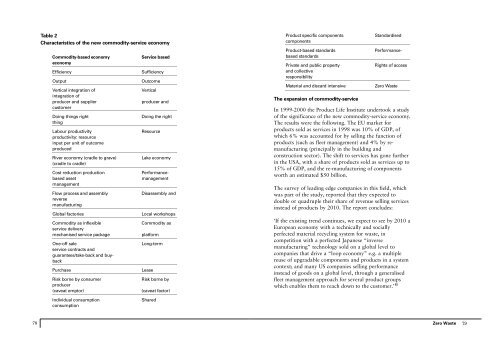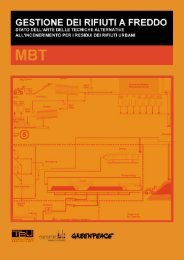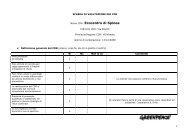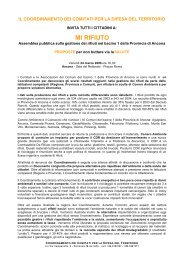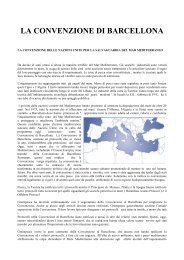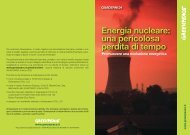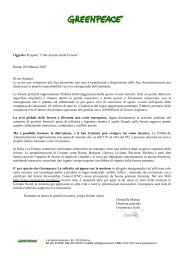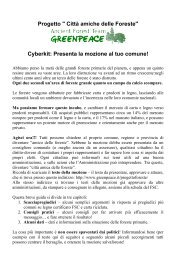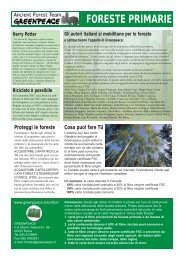Zero Waste by Robin Murray, Greenpeace Environmental Trust 2002
Zero Waste by Robin Murray, Greenpeace Environmental Trust 2002
Zero Waste by Robin Murray, Greenpeace Environmental Trust 2002
Create successful ePaper yourself
Turn your PDF publications into a flip-book with our unique Google optimized e-Paper software.
Table 2<br />
Characteristics of the new commodity-service economy<br />
Commodity-based economy<br />
economy<br />
E fficiency<br />
Output<br />
Ve rtical integration of<br />
integration of<br />
p roducer and supplier<br />
customer<br />
Doing things right<br />
thing<br />
Labour productivity<br />
p roductivity: re s o u rce<br />
input per unit of outcome<br />
p roduced<br />
River economy (cradle to grave)<br />
(cradle to cradle)<br />
S e rvice based<br />
S u fficiency<br />
Outcome<br />
Ve rt i c a l<br />
p roducer and<br />
Doing the right<br />
R e s o u rc e<br />
Lake economy<br />
Cost reduction production P e rf o rm a n c e -<br />
based asset<br />
m a n a g e m e n t<br />
management<br />
Flow process and assembly<br />
reverse<br />
manufacturing<br />
Global factories<br />
Commodity as inflexible<br />
s e rvice delivery<br />
mechanised service package<br />
O n e - o f sale<br />
s e rvice contracts and<br />
guarantees/take-back and buyback<br />
P u rchase<br />
Risk borne <strong>by</strong> consumer<br />
p roducer<br />
(caveat emptor)<br />
Disassembly and<br />
Local workshops<br />
Commodity as<br />
p l a t f o rm<br />
L o n g - t e rm<br />
Lease<br />
Risk borne <strong>by</strong><br />
(caveat factor)<br />
P roduct specific components<br />
components<br />
S t a n d a rd i s e d<br />
P roduct-based standards P e rf o rm a n c e -<br />
based standards<br />
Private and public pro p e rty<br />
and collective<br />
responsibility<br />
Material and discard intensive<br />
The expansion of commodity-serv i c e<br />
Rights of access<br />
Z e ro <strong>Waste</strong><br />
In 1999-2000 the Product Life Institute undertook a study<br />
of the significance of the new commodity-service economy.<br />
The results were the following. The EU market for<br />
products sold as services in 1998 was 10% of GDP, of<br />
which 6% was accounted for <strong>by</strong> selling the function of<br />
products (such as fleet management) and 4% <strong>by</strong> remanufacturing<br />
(principally in the building and<br />
construction sector). The shift to services has gone further<br />
in the USA, with a share of products sold as services up to<br />
15% of GDP, and the re-manufacturing of components<br />
worth an estimated $50 billion.<br />
The survey of leading edge companies in this field, which<br />
was part of the study, reported that they expected to<br />
double or quadruple their share of revenue selling services<br />
instead of products <strong>by</strong> 2010. The report concludes:<br />
‘If the existing trend continues, we expect to see <strong>by</strong> 2010 a<br />
European economy with a technically and socially<br />
perfected material recycling system for waste, in<br />
competition with a perfected Japanese “inverse<br />
manufacturing” technology sold on a global level to<br />
companies that drive a “loop economy” e.g. a multiple<br />
reuse of upgradable components and products in a system<br />
context; and many US companies selling performance<br />
instead of goods on a global level, through a generalised<br />
fleet management approach for several product groups<br />
which enables them to reach down to the customer.’ 52<br />
Individual consumption<br />
consumption<br />
S h a re d<br />
78<br />
<strong>Zero</strong> <strong>Waste</strong><br />
79


